Precious bone that provides the basis for keeping teeth healthy and serves as the foundation for natural gum tissue bulk and height most often is “lost” due to disease (gingivitis, periodontitis) or the accumulation of missing teeth.
Physical trauma, especially where the blood and nutrient supply within the bone itself becomes interrupted, can cause bone loss over time.
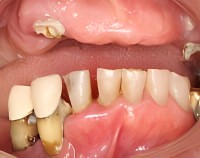
The three largest patient populations that have serious or complicated issues of above average bone loss are patients who:
- Have a long history of untreated or inadequately treated gum disease
- Are long term denture wearers
- Have worn bridgework or partials for a long period of time
No Bone Left
Long term denture wearers who are now in their 60’s, 70’s and even 80’s are discovering that the bone loss that is typically associated with common, unsecured or retained dentures is cumulative to the extent that replacement dentures may not be possible.
The ridge of bone and gum tissue that normally supports a denture appears to melt away or disappear over years and years of use.
Dentures require a certain minimum height of bone and width of bone for proper fitting. Denture relining are commonly used, as needed, to form a tighter fit around the ridge and thinning gums.
Patients who started wearing denture products at a young age or patients who “put up” with loose fitting, rocking dentures will experience bone loss that can render an upper or lower jaw being incapable of supporting a normal denture.
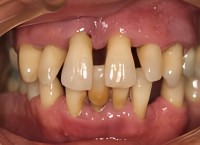
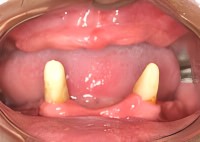
New Options for New Problems
While bone grafting products have been in use for as long as anyone can remember, newer, creative treatment protocols have been developed that enable implant dentists, prosthodontists and periodontists to not only replace commonly lost bone (e.g., extractions), but recreate larger quantities of bone for more complex dental problems.
Narrow Bony Ridge
Untreated extractions or missing teeth beneath a common dental bridge can routinely cause a narrowing or thinning of the bony ridge that our teeth are rooted in. In simple cases, the insertion of an implant device properly centered can expand the ridge to a more normal width to accommodate an implant device that is appropriately sized for a particular tooth.
In cases where the span of missing teeth is longer….or the span is the entire length of the jawbone arch, narrow ridges are being treated more and more with ridge splitting, using special instruments that splits the ridge and creates an idealized pocket between the original walls of the bony ridge that is filled with a form of pulverized bone matrix product.
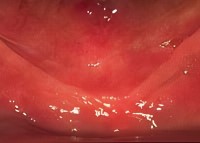
Creating New Width: Ridge Expansion
The ridge split procedure creates an optimal environment of two solid walls of existing bone that is augmented with additional bone graft material being inserted between the walls of bone in the amount needed to create what is defined as a normal ridge of healthy bone for any given patient.
Dental implants are strategically placed throughout the arch, creating an anchoring system that best secures the tooth replacement choice of the patient (fixed or removable prosthetics). Pulverized bone graft material is then firmly packed into the widened ridge through the entire arch.
Bone regeneration proceeds predictably and rapidly, creating a new, wider healthy width of bone that becomes fully osseointegrated with the patient’s existing bone and the implant devices. For many patients the augmented ridge of bone oftentimes represents an improvement over what Mother Nature originally provided.

to Wide
Creating New Height: Block Grafting
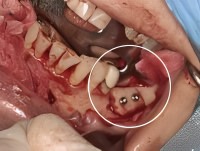
In our practice, the use of patient donated blocks of bone to recreate the normal height is the favored procedure that produces excellent results that are healthy and durable.
Old untreated tooth extractions, long term use of denture partials and certain types of bridgework can cause severe loss of bone height.
The adjacent picture depicts how bone has been added to the lower jaw for creating new implant sites for new molar teeth…. critical for biting and chewing. The patient’s original bone height in this location was non-existent, preventing any form of tooth replacement. – Ridge Expansion – Lower Jaw Thin to Wide
To further maximize the bone block grafting procedure, bone is harvested from the oral cavity or chin area, thereby providing the healthiest bone tissue match possible. Rejection issues or osseointegration delays that can occur with other types of exogenous (non patient donated) grafting procedures are essentially eliminated.
Once healed and fully osseointegrated, the screws are removed and placement of the implant device(s) takes place.
Call 414-464-9021 for information on any of our services.
Check out our Dental Blog >>
Read our Patient Case Studies >>
Hampton Dental Associates is proud to offer affordable dentistry programs to help you regain your perfect smile.
Learn more about our affordable dentistry options.


